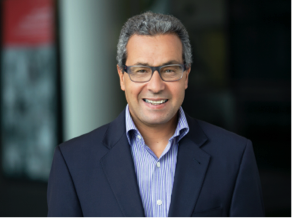 A few months ago I co-led a roundtable with Susie Ellis, CEO of the Global Wellness Institute, about redefining wellness at work. 25 top leaders across industries and countries participated; the conversation was forward thinking and lively. Together we agreed: it’s high time for work to be an avenue where wellbeing is gained not lost, and where people amplify their capacity to thrive.
A few months ago I co-led a roundtable with Susie Ellis, CEO of the Global Wellness Institute, about redefining wellness at work. 25 top leaders across industries and countries participated; the conversation was forward thinking and lively. Together we agreed: it’s high time for work to be an avenue where wellbeing is gained not lost, and where people amplify their capacity to thrive.
Voicing that vision of wellbeing was energizing for sure, but I know from experience that putting those words into practice takes real guts. Leaders who embark on this journey don’t simply install employee wellness benefits and programs or implement engagement and productivity initiatives; they earnestly reexamine the organization’s mission, priorities, business models, products and services, and ways of operating. Everything gets reevaluated through the lens of advancing wellbeing, an undertaking that can’t help but be transformational.
Few organizations have traveled this path as long as Johnson & Johnson, a +120-year-old enterprise with 200 operating companies that employ 126,500 people worldwide. Putting health in the hands of individuals has been J&J’s core business from the beginning, from manufacturing the first mass-produced sanitary napkins and consumer-applied adhesive bandages in the late 1800’s to generating revolutionary medical devices and biotech startups today.
Fortunately, J&J’s Chief Medical Officer Dr. Fikry Isaac – a friendly gentleman who goes by the name “Fik” – sat next to me during the roundtable. So I asked him what he thinks it takes to be an authentic wellbeing leader. I’m delighted to share his advice as part of Wisdom Works’ Face of Wellbeing Leadership series.
Me: What does it mean to lead wellbeing?
Fik: In my view, leading wellbeing is about helping each person bring out his or her best, front and center. Everyone can be their best self regardless of how they look, where they are, or what they do. We want people to feel good about themselves, enthusiastic about their work, and connected to their deeper purpose. Our role as a company is to create an environment where that is encouraged.
Me: How does Johnson & Johnson lead wellbeing as a company?
Fik: A critical business imperative for J&J is to bring health solutions not just to our customers, consumers, and patients but also to our employees and their families. We can’t be effective as a business without caring for our own people. So that is part of our value system, our credo outlining our responsibilities to stakeholders, including the men and women working for us around the world. Even broader, we also take responsibility for the health of communities where we operate and live.
We believe our health-centered approach translates into the bottom line; if we make good on our responsibilities to enhance wellbeing for anyone who is part of our footprint, we will reap a fair return on our investment. We’ll flourish as a company, as will the people who are part of it.
Simply, the heart of enhancing wellbeing for J&J is about being a company that cares.
Me: What started J&J on the journey of wellbeing leadership?
Fik: Our journey certainly began at the top. In our company archives, you’ll find one of our earliest leaders, General Johnson, made health a priority; for example, he provided small, onsite clinics for U.S. Army personnel who needed rest and recuperation, and he built basketball and volleyball courts to encourage fun competitions and play. So health and wellness has been part of the fabric of the company from the onset.
Yet in 1978, our CEO Jim Burke declared a new vision for J&J: to have the healthiest workforce in world. By infusing the theme of prevention and wellness into our culture and providing convenient opportunities for employees to pursue whole, fulfilling lives, Jim felt we’d benefit from more vital employees and reduced healthcare costs. In fact, from 2002-2008 we estimate that our wellness efforts saved our company $565 per employee per year and an average of $1.88 – $3.92 for every dollar spent on the program.
Alex Gorsky, our CEO today, wholeheartedly backs Jim’s original vision to foster the world’s healthiest workforce. And he’s taken it a step further; he wants our company to inspire people – no matter who or where they are – to take better care of themselves and their loved ones. That applies throughout our business system and community relationships around the world, not just for our employees.
Me: In your role as senior leader, how do you think J&J can impact wellness on the world stage?
Fik: My vision is for our company to make a difference in how view health altogether. Today people are too focused on specific dimensions such as total cholesterol or an ideal body weight. We need to help people focus on what matters to them most and for the long term. This means changing the dialogue from traditional ways we think about health to a more personalized, holistic definition of wellness and wellbeing.
I also envision our company creating a large-scale ripple effect through what we do as a responsible employer. I expect us to spread what we’ve learned and to apply it beyond the workforce so that we have a bigger impact on families and communities. We can positively impact the world at large by making wellness infectious. To do this requires that we influence policy makers, advocate for wellbeing, and convene opportunities to showcase best practices that address the world’s pressing issues leading to chronic disease, illness, and unhappy lives.
For instance, we successfully implemented our tobacco-free workplace policy in 2007. For us, it wasn’t just about institutionalizing the policy; it was about offering employees and their families positive, non-judgmental ways to help them stop smoking for good. Today we’re sharing what we’ve learned with interested governments such as the USA, China, and Japan. These conversations with country and company leaders are contributing to an emerging gold standard for tobacco-free workplaces worldwide.
Leading by example is important for us. Once we implement a new wellness policy or approach, we are keen to learn from it, as well as share our toolkits for change and the insights we’ve gained from applying the policy in markets and communities globally.
Me: Have you been able to tie your wellness efforts to your company performance?
Fik: This is challenging question. We can’t make a direct link between wellness and profitability, at least not yet. Part of our business dynamic is to acquire and divest companies; with an organization constantly in flux like ours, it would be hard to say what role wellness efforts alone play in business performance. We do see the impact between our focus on wellness and employee engagement however. As an example, employee engagement scores are significantly better in our workplaces where we’ve helped employees (about 50,000 so far) focus on their ultimate mission and life purpose through our Energy for Performance in Life program.
The question you’re asking me is: Does a corporation that prioritizes health and wellbeing do better in terms of its bottom line? To help our company and other organizations integrate wellbeing in how business success is measured, we recently developed the Health And Performance Index. We’re currently validating this tool inside and outside J&J. We’ll share what we learn from it with any organization, community, or person on this wellness journey. We believe health and wellbeing is mission critical for us all.
READ MORE





